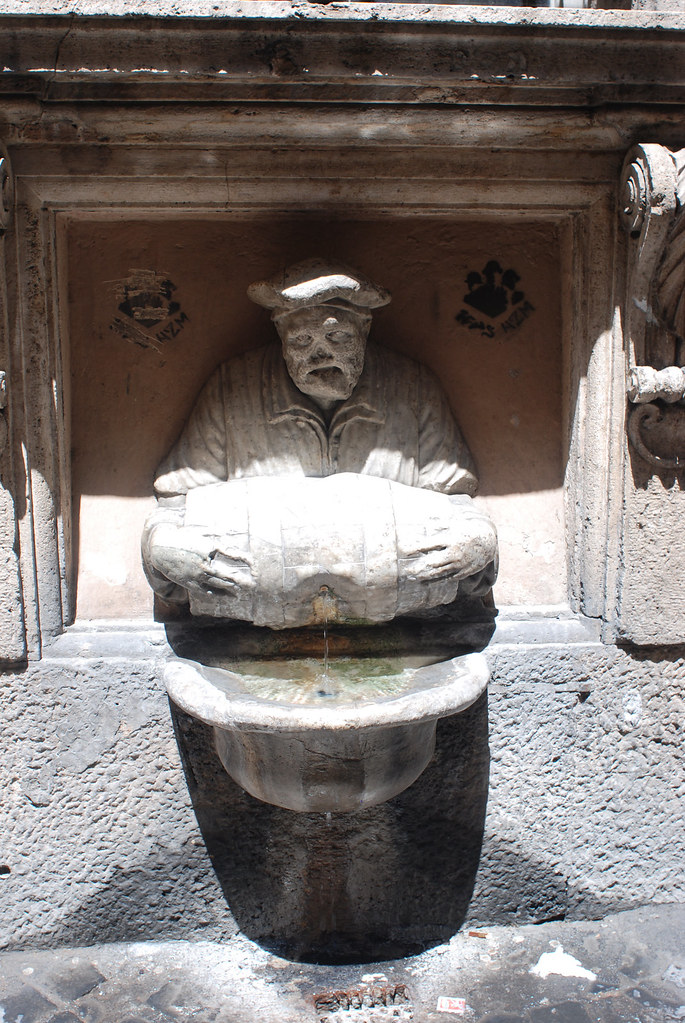On Friday, the New York Times published a
small blurb that, among other things, lamented the fact that drinking fountains in America are not “as ubiquitous as fire hydrants,” forcing people to carry water bottles around. I felt the article was a cue for me to blog about tap water and drinking fountains in Europe.

Water fountains are indeed ubiquitous in Rome. Still I felt compelled to refill and carry a water bottle. Murphy’s Law told me that there would be no water exactly when I needed it. Plus even a short walk under the blazing Italian sun caused dehydration.
Of all drinking fountains the
New York Times article surveyed only one (in San Francisco) was designed to provide water to our four-legged friends. The omission especially stands out after seeing all the happy omni present canines in Europe. In Bern and Zurich, most water fountains collected the water in a pool below, and dogs, little ones helped by their owners, happily drank from the pools.

Europeans do not tend to drink much water with their meals. Italians seem to prefer carbonated water. Everyone also seems to be used to the restaurant charging for every item served, including bread. Given all these facts, I did not expect to be automatically served tall glasses of cold tap water, but often I could not resist asking for one.
Both in Munich and in Berlin, when we asked, we did get tap water for free, though it came in tiny glasses (2 dcl). Germany was where the free tap water bliss ended. In Prague a waitress gently explained that tap water was “not very good” and brought out a bottle of water. In Venice the answer was much shorter—“no service.” The waiter almost snorted when I asked.
Paying for bottled water is far from shocking. I am also quite certain that people in the Czech Republic really do believe that their tap water is bad—nobody I know in Moscow drinks the tap water without filtering or boiling it. The paradox lies in the fact that while Rome has wonderful water fountains in every little piazza, and Venice prides itself on the purity and the excellent taste of its tap water, the restaurants refuse to serve it.
The change we experienced going from Venice to Lauterbrunnen in the Berner Oberland region of Switzerland could not be more drastic. The air was cool, public bathrooms were free (more on bathrooms in a separate post), and waiters did not even blink when asked for a glass of tap water. Most (though not all) restaurants still charged 1 Swiss Frank per glass, an improvement over €3.00 for 500ml bottle.
 Our walk also took us through the Tiergarten, a large park in the center of Berlin designed in the 1830's that was once a hunting ground. As we walked past the Victory Column, I could not help but think back to U2's Stay (Faraway, So Close) music video. In the video (as well as in Wim Wender's movie of the same name) this 66+ meter column with a sculpture of Victoria on top servers as the gathering place for angels watching over the city.
Our walk also took us through the Tiergarten, a large park in the center of Berlin designed in the 1830's that was once a hunting ground. As we walked past the Victory Column, I could not help but think back to U2's Stay (Faraway, So Close) music video. In the video (as well as in Wim Wender's movie of the same name) this 66+ meter column with a sculpture of Victoria on top servers as the gathering place for angels watching over the city. As we passed under the Brandenburg Gate, we noticed a large crowd standing in front of the enterance to Hotel Adlon. Apparently, Bono was signing autographs at the entrance of the hotel. I climbed a railing for a better look, but still could not see anything. What can I say--the man is short.
As we passed under the Brandenburg Gate, we noticed a large crowd standing in front of the enterance to Hotel Adlon. Apparently, Bono was signing autographs at the entrance of the hotel. I climbed a railing for a better look, but still could not see anything. What can I say--the man is short. 






